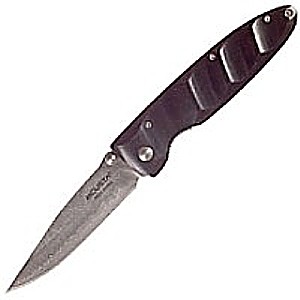In my previous post, I spoke of the use of woods in the manufacturing of
knives, specifically, knife handles. In today's blog, I will focus more on the use of metals, advantages and disadvantages. I won't cover ever advantage or disadvantage so if you feel that something is missing that is just too important to be left out, feel free to leave a comment.
Most metals can be used to manufacture knife handles but this doesn't mean that they would make good knife handles. Some would be to costly to produce, but have been used such as gold and
silver, others would be too soft and/or too heavy such as lead and others would be too dangerous such as uranium. Most of the knives made with metal handles and metal components on a knife are made of stainless steel, aluminum, and/or titanium.
Stainless steel advantages include, but are not limited to, strength, corrosion resistance, the ease of manufacture, relatively low cost, can be etched and/or engraved in many cases and the ease of keeping it clean and protected. In appearance, stainless steel is rather bland, in my opinion. It provides a smooth transition from blade to handle if the blade is also made of stainless steel. I like different textures and styles and unless the blade is a differing color and/or texture than the handle, I would opt for a different knife.
Below is an example of a knife with a stainless steel handle.
 |
| Byrd Pelican BY06PS |
Aluminum offers a lighter weight material that stainless steel and shares similar advantages such as corrosion resistance, the ease of maintenance, the ability to etch and/or engrave the surface and it's relative low cost. Aluminum is not as strong as stainless steel though, but through a process called anodization, aluminum can be offered in a variety of colors that are very durable in reference to color fading, scratching and normal wear and tear.
Below is an example of a knife with an aluminum handle.
 | |
| Darrel Ralph Assisted Opening Gun Hammer |
Titanium is the most expensive of the more commonly used metals. It is difficult to manufacture and machine. However, it offers a lightweight metal that is corrosion resistant, easy to maintain, and has high strength and durability.
Below is an example of a knife with a half of the handle in titanium and the other have in black G-10 laminate.
 |
| Zero Tolerance (ZT Knives) Hinderer Folder 0551 Limited Edition | |
|
Leaving a metal handle smooth does have one primary disadvantage and that is grip. In a hard use environment, you want the knife to stay in your hand, you don't want it to slip, slide, and/or fall all of which can result in serious physical injury. In the last knife pictured above, the Zero Tolerance Hinderer Folder, the titanium backside of the knife is left smooth, but the front of the knife features a G-10 laminate surface as to offer the end user more "tooth" or grip to the knife handle to help prevent an accident, but also to get the task at hand done more efficiently. A good grip on the knife allows the user more control of the knife and how it's being used.
In future blogs, I will be writing about other types of knife handle materials. Keep checking back and don't forget to visit my website -
www.NationalKnives.com.
Rob









